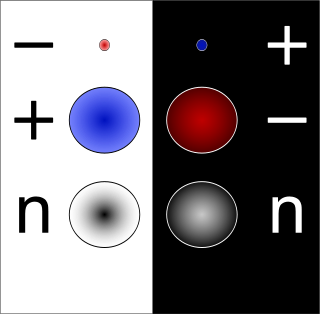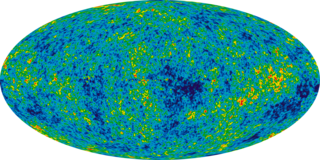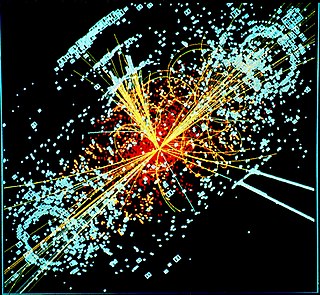
In particle physics, every type of particle of "ordinary" matter is associated with an antiparticle with the same mass but with opposite physical charges. For example, the antiparticle of the electron is the positron. While the electron has a negative electric charge, the positron has a positive electric charge, and is produced naturally in certain types of radioactive decay. The opposite is also true: the antiparticle of the positron is the electron.

The Big Bang is a physical theory that describes how the universe expanded from an initial state of high density and temperature. The notion of an expanding universe was first scientifically originated by physicist Alexander Friedmann in 1922 with the mathematical derivation of the Friedmann equations. The earliest empirical observation of the notion of an expanding universe is known as Hubble's law, published in work by physicist Edwin Hubble in 1929, which discerned that galaxies are moving away from Earth at a rate that accelerates proportionally with distance. Independent of Friedmann's work, and independent of Hubble's observations, physicist Georges Lemaître proposed that the universe emerged from a "primeval atom" in 1931, introducing the modern notion of the Big Bang.

In particle physics, a meson is a type of hadronic subatomic particle composed of an equal number of quarks and antiquarks, usually one of each, bound together by the strong interaction. Because mesons are composed of quark subparticles, they have a meaningful physical size, a diameter of roughly one femtometre (10−15 m), which is about 0.6 times the size of a proton or neutron. All mesons are unstable, with the longest-lived lasting for only a few tenths of a nanosecond. Heavier mesons decay to lighter mesons and ultimately to stable electrons, neutrinos and photons.

In particle physics, proton decay is a hypothetical form of particle decay in which the proton decays into lighter subatomic particles, such as a neutral pion and a positron. The proton decay hypothesis was first formulated by Andrei Sakharov in 1967. Despite significant experimental effort, proton decay has never been observed. If it does decay via a positron, the proton's half-life is constrained to be at least 1.67×1034 years.

The Standard Model of particle physics is the theory describing three of the four known fundamental forces in the universe and classifying all known elementary particles. It was developed in stages throughout the latter half of the 20th century, through the work of many scientists worldwide, with the current formulation being finalized in the mid-1970s upon experimental confirmation of the existence of quarks. Since then, proof of the top quark (1995), the tau neutrino (2000), and the Higgs boson (2012) have added further credence to the Standard Model. In addition, the Standard Model has predicted various properties of weak neutral currents and the W and Z bosons with great accuracy.
In theoretical physics, a chiral anomaly is the anomalous nonconservation of a chiral current. In everyday terms, it is equivalent to a sealed box that contained equal numbers of left and right-handed bolts, but when opened was found to have more left than right, or vice versa.

Asymmetry is the absence of, or a violation of, symmetry. Symmetry is an important property of both physical and abstract systems and it may be displayed in precise terms or in more aesthetic terms. The absence of or violation of symmetry that are either expected or desired can have important consequences for a system.

In physical cosmology, baryogenesis is the physical process that is hypothesized to have taken place during the early universe to produce baryonic asymmetry, i.e. the imbalance of matter (baryons) and antimatter (antibaryons) in the observed universe.

The LHCb experiment is a particle physics detector experiment collecting data at the Large Hadron Collider at CERN. LHCb is a specialized b-physics experiment, designed primarily to measure the parameters of CP violation in the interactions of b-hadrons. Such studies can help to explain the matter-antimatter asymmetry of the Universe. The detector is also able to perform measurements of production cross sections, exotic hadron spectroscopy, charm physics and electroweak physics in the forward region. The LHCb collaborators, who built, operate and analyse data from the experiment, are composed of approximately 1650 people from 98 scientific institutes, representing 22 countries. Vincenzo Vagnoni succeeded on July 1, 2023 as spokesperson for the collaboration from Chris Parkes. The experiment is located at point 8 on the LHC tunnel close to Ferney-Voltaire, France just over the border from Geneva. The (small) MoEDAL experiment shares the same cavern.

A sphaleron is a static (time-independent) solution to the electroweak field equations of the Standard Model of particle physics, and is involved in certain hypothetical processes that violate baryon and lepton numbers. Such processes cannot be represented by perturbative methods such as Feynman diagrams, and are therefore called non-perturbative. Geometrically, a sphaleron is a saddle point of the electroweak potential.
In physical cosmology, leptogenesis is the generic term for hypothetical physical processes that produced an asymmetry between leptons and antileptons in the very early universe, resulting in the present-day dominance of leptons over antileptons. In the currently accepted Standard Model, lepton number is nearly conserved at temperatures below the TeV scale, but tunneling processes can change this number; at higher temperature it may change through interactions with sphalerons, particle-like entities. In both cases, the process involved is related to the weak nuclear force, and is an example of chiral anomaly.

The cosmic neutrino background is the universe's background particle radiation composed of neutrinos. They are sometimes known as relic neutrinos.

In physical cosmology, the electroweak epoch was the period in the evolution of the early universe when the temperature of the universe had fallen enough that the strong force separated from the electronuclear interaction, but was still high enough for electromagnetism and the weak interaction to remain merged into a single electroweak interaction above the critical temperature for electroweak symmetry breaking. Some cosmologists place the electroweak epoch at the start of the inflationary epoch, approximately 10−36 seconds after the Big Bang. Others place it at approximately 10−32 seconds after the Big Bang, when the potential energy of the inflaton field that had driven the inflation of the universe during the inflationary epoch was released, filling the universe with a dense, hot quark–gluon plasma.
A weakless universe is a hypothetical universe that contains no weak interactions, but is otherwise very similar to our own universe.

In particle physics, CP violation is a violation of CP-symmetry : the combination of C-symmetry and P-symmetry. CP-symmetry states that the laws of physics should be the same if a particle is interchanged with its antiparticle (C-symmetry) while its spatial coordinates are inverted. The discovery of CP violation in 1964 in the decays of neutral kaons resulted in the Nobel Prize in Physics in 1980 for its discoverers James Cronin and Val Fitch.

The chronology of the universe describes the history and future of the universe according to Big Bang cosmology.

In classical physics and general chemistry, matter is any substance that has mass and takes up space by having volume. All everyday objects that can be touched are ultimately composed of atoms, which are made up of interacting subatomic particles, and in everyday as well as scientific usage, matter generally includes atoms and anything made up of them, and any particles that act as if they have both rest mass and volume. However it does not include massless particles such as photons, or other energy phenomena or waves such as light or heat. Matter exists in various states. These include classical everyday phases such as solid, liquid, and gas – for example water exists as ice, liquid water, and gaseous steam – but other states are possible, including plasma, Bose–Einstein condensates, fermionic condensates, and quark–gluon plasma.

In cosmology, recombination refers to the epoch during which charged electrons and protons first became bound to form electrically neutral hydrogen atoms. Recombination occurred about 378000 years after the Big Bang. The word "recombination" is misleading, since the Big Bang theory does not posit that protons and electrons had been combined before, but the name exists for historical reasons since it was named before the Big Bang hypothesis became the primary theory of the birth of the universe.
The Affleck–Dine mechanism is a postulated mechanism for explaining baryogenesis during the primordial Universe immediately following the Big Bang. Thus, the AD mechanism may explain the asymmetry between matter and antimatter in the current Universe. It was proposed in 1985 by Ian Affleck and Michael Dine of Princeton University.

The CPLEAR experiment used the antiproton beam of the LEAR facility – Low-Energy Antiproton Ring which operated at CERN from 1982 to 1996 – to produce neutral kaons through proton-antiproton annihilation in order to study CP, T and CPT violation in the neutral kaon system.




















